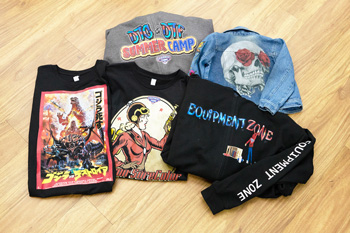Direct-to-Film (DTF) is a recent decorating technology in which artwork is inkjet-printed onto an intermediate film that can be transferred using heat onto cotton, polyester and other fabrics, as well as treated leather. Once prepared, the transfers can be used immediately, stored for later use, or sold as a final product.
In simplest terms, the transfers are printed with the color layer first, then the white base. After printing, and while the ink is still wet, the graphic is coated in a powdered adhesive which must be heated to cure. A critical step in the DTF process is thorough and uniform curing of the adhesive. A properly cured transfer will have a glossy, orange peel texture.
Printed transfers are generally cured using one of four types of equipment:
Heat Presses
To cure the transfer on a clam shell heat press, the bottom platen should be heated. For presses without a bottom heating element, the press can be closed for 30 seconds to heat the bottom platen. Lay the transfer with adhesive side up on the bottom platen and hover the top platen above the transfer as closely as possible without touching. For swing-away models, set the machine to hover just above the transfer without making contact.
Dwell time and temperature will depend on the make of heat press used, but estimate between 1 and 5 minutes per transfer at 275° to 350°F.
Since most DTG and DTF shops own a heat press, this option is likely already available. However, using a heat press to cure DTF adhesives requires operator time and attention, and prevents the heat press from being used for other tasks, potentially creating a bottleneck in production. Most operate on 120V and should be operated below a separate powered exhaust hood to evacuate fumes. Average cost ranges from $200 to $2000 depending on brand and features.
Curing Ovens
Designed to cure individual sheets of DTF film up to 18 x 24 in. (460 x 610 mm), curing ovens are single-function devices that provide uniform heating at temperatures to 300°F (150°C). Once the oven is heated to the desired temperature, the transfer sheet is inserted into a tray that slides in and out to retain the heat inside the body of the device. An automatic timer and alarm signals the operator to remove the transfer. A typical setting is 260°F at 120 seconds. A fume extractor or separate powered exhaust hood is strongly recommended.
Most operate on 120V and fit on a tabletop or counter, freeing up heat presses for other uses. Average cost ranges from $200 to $1000.
Flash Cure Units
With flash cure units, the transfer is placed on a vented platen over which the high wattage heater is swiveled for uniform curing. Models with dual rotary platens can double productivity. Head leveling achieves edge-to-edge consistency. For shops that also offer manual screen printing, flash cure units are likely on hand and offer relatively hands-free results in about a minute. As with heat presses, flash cure units require a separate powered exhaust system to evacuate fumes. Entry-level units operate on 120V and should be operated below a separate powered exhaust hood to evacuate fumes. Average cost ranges from $150 to $1400.
Conveyor Dryers
The most efficient option is a small tabletop infrared conveyor dryer. Easy to operate, the freshly powdered transfer is placed on the conveyor belt which travels through the heating chamber to cure, hands-free. The height-adjustable heating element and digitally-controlled temperature and belt speed allow precision settings for repeatable results. A catch bin at the end of the conveyor allows multiple transfers to be placed on the belt in succession, with no operator oversight, improving productivity. Infrared conveyor dryers can also be used to cure pretreatment as well as DTG printed garments.
For commercial shops requiring high production rates, larger conveyor dryers allow for multiple rows of transfers in addition to DTG and screen-printed garments.
Unlike heat presses, curing ovens and flash cure units, some compact conveyor dryers are available with integral powered exhaust to remove fumes and moisture from the work area, eliminating the cost of separate exhaust hoods. Tabletop units operate on 120V and 240V and start around $1,600, or $2,600 with powered exhaust.
Time cost outweighs equipment cost
Because your curing equipment will likely last many years, its one-time cost is typically insignificant relative to the time it takes away from profit-making activities throughout your workdays.
Consider that heat presses, flash cure units and curing ovens can burn your transfers if you forget to remove them in time. As a result, they require your constant attention, taking you away from production, prepress and even sales activities that generate income — every day over the useful life of your curing equipment.
For example, curing each transfer using a heat press takes one to five minutes and requires your attention to remove each one in time. With an entry-level Vastex D-100 tabletop conveyor dryer, however, you need only place transfers onto the belt, since they fall into a bin at the discharge end with no oversight on your part, at rates to 50 transfers per hour at 70-90 seconds each.
If you're just starting out, you may not need any type of automation, but once your business begins to grow, replacing time consuming manual equipment will end up costing you more than purchasing time-saving automated equipment at the onset.
Full disclosure: Vastex manufactures and/or markets heat presses, flash cure units and conveyor dryers, all of which can be employed to cure direct-to-film adhesives, but with varying degrees of effectiveness.














